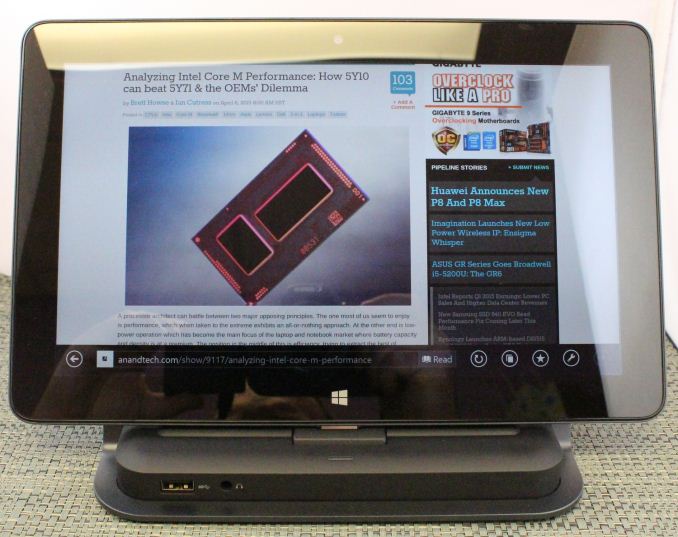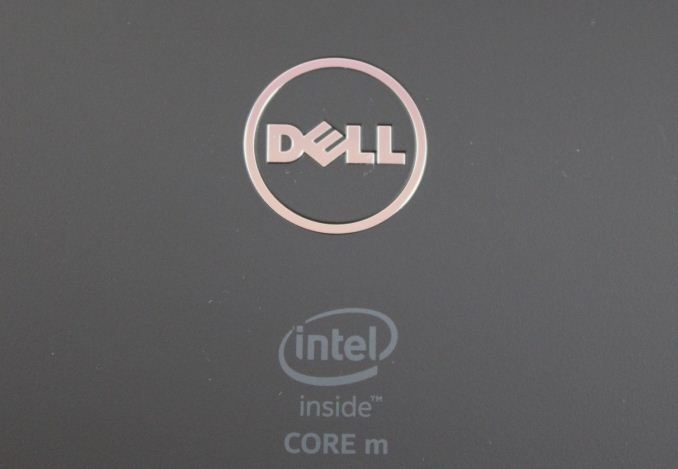The Dell Venue 11 Pro 7000 Review
by Brett Howse on April 16, 2015 8:00 AM EST- Posted in
- Tablets
- Dell
- Windows 8.1
- Core M
Final Words
In my time with the Venue 11 Pro, what has defined the tablet is not the hardware itself, but the accessories. Dell offers such a range of options that the tablet can be anything from a desktop PC, to a clamshell laptop, to a very portable mobile device. They really have hit all of the options which gives the customers a lot of choice in what they want to do with this device.
Starting with the dock, Dell has crafted a sturdy, solid, easy to use dock which offers plenty of ports. USB, Ethernet, headphones, HDMI, and DisplayPort are all on tap, so the Venue 11 Pro can easily be plugged in and used as a desktop replacement. The finish and materials of the dock are top notch, and amazingly it only sells for $79.99, which is much less than the Surface Dock that Microsoft sells. It is not perfect due to the 10/100 Mbps Ethernet, but for many offices, the addition of any wired networking is a big improvement over wireless anyway, and is sometimes necessary.
The Stylus is also excellent. It is powered by a single AAA battery, which if it does ever die, is easy to obtain and replace. The point is very smooth, and glides effortlessly over the tablet’s glass. Accuracy was also excellent on this new version of the Synaptics stylus, and the only time I had issues was at the very edges of the display. It is great for writing, and it makes a big difference when navigating the desktop as well.
The Mobile keyboard dock is not everything I hoped it would be, and is the one accessory that really let me down. The included battery can make a big difference in overall run time, which is excellent, but it adds a lot of thickness and a lot of mass to the device. Not only that, but the keyboard and trackpad are sub-par, and were frustrating to use. They are both passable, but I have used other Dell devices which offer a much better experience, so Dell needs to step up here especially with the price. The tablet does latch into the keyboard very well though, which makes it a much better laptop experience than a device which may have a non-connected or Bluetooth keyboard attachment.
Dell did not ship me the slim keyboard, so I will not make any comments on the use of that particular accessory. It will obviously provide a keyboard when needed, without all of the added bulk of the mobile version, but without the laptop hinge and battery which is part of the mobile version.
The Dell Venue 11 Pro tablet, when considered as a pure tablet, has some shortcomings due to the very nature of what makes it an excellent hybrid device. At 10.8 inches in screen size, it never felt too big to use as a tablet, but the extra thickness and mass of it make it hard to compete against some of the pure tablets out there. It does use the extra size to great effect though, with the Venue 11 Pro packing a full personal computer into its chassis. These are not tablet parts inside, with a Core processor, 8 GB of memory, and a Solid State Drive at the heart of this device. The performance is quite a bit better than pretty much all other fanless tablets around.
We have evaluated Core M in detail, and the Venue 11 Pro really pushes Core M to the limit of what it is capable of, but that does not take away from the performance that is there. Compared to a Bay Trail Atom powered tablet, there really is no competition. The performance delta between Bay Trail and Broadwell, even in similar power envelopes, is massive. For what it was meant to do, Core M delivers outstanding performance in a fanless tablet. Once you start comparing it to higher TDP Core parts, it can fall down a bit, but none of them can be used in a fanless device like this one. It will be curious to see how it compares to the Cherry Trail based Atom cores that have just started to appear in devices such as the Microsoft Surface 3.
Using the Venue 11 Pro on a day to day basis never really felt like it was a tablet. The combination of plenty of memory, a SSD, and Core M, really made it feel like a proper ultrabook. Battery life was also quite good considering the compact size and relatively small battery inside. Adding the mobile keyboard dock increases battery life to great levels.
Really, there is not a lot of competition for the Venue 11 Pro right now. If you are looking for a business class tablet with a Core processor and proper accessories like a dock, there is the Dell Venue 11 Pro and the Microsoft Surface Pro 3. Both feature Ultrabook class components inside, but have different trade-offs, with the Surface Pro 3 having better performance and active cooling. That puts the Venue 11 Pro into a class of its own, with the fanless design of a Core M tablet. The starting price of just $699 undercuts the Surface Pro 3 Core i3 version by $150, which is not insignificant.















92 Comments
View All Comments
liahos1 - Thursday, April 16, 2015 - link
can you guys start adding normalized battery life for these products against tablets as well?ingwe - Thursday, April 16, 2015 - link
I would really appreciate having that back too. It isn't like I particularly care from a user perspective (obviously overall battery life is more important), but I really like to see how different platforms stack up in this regard.jjj - Thursday, April 16, 2015 - link
No idea why i even clicked , Core M is a horrible product for the price so got no interest at all in anything with it - hopefully AMD. Nvidia ,Qualcomm and ARM will catch up in single threaded perf at a fraction of the price soon. Well,maybe not ARM since A72 seems to be actually smaller than A57 , die size wise.Anyway this actually made me laugh when i realized that it kinda looks like the Moto Xoom except with thicker bezels (first Android tab ,4 years ago). OEMs should put more effort than this even in 100$ tabs.
Speedfriend - Thursday, April 16, 2015 - link
Apple managed a giant 10% improvement in single core performance between A7 and A8...So with the top Core M single core performance around 60% higher than the A8X, Apple will need to produce a miracle.
And as for the cost, a 128gb iPad Air 2 is $699+$100 for a decent keyboard case versus the low end core M equipped Asus T300 Chi which comes with a keyboard for $699. And the high end T300Chi, which will obliterate the iPAd Air 2 comes in at $899 with 8GB of memory
jjj - Thursday, April 16, 2015 - link
Apple has no relevance, they have many limitations and high prices so no reason to even consider them.MrSpadge - Thursday, April 16, 2015 - link
Apple has a lot of relevance here, because they've got the ARM core with the highest single threaded performance. If anyone closes the gap to Intel it's going to be them. Even if Qualcom could do it, they need to put 4 cores into phones for the "bigger is better" crowd, which means any single core must not be too big - otherwise people will complain that it gets too hot.And if Apple only got 10% on their last refresh they may be approaching the region of diminishing returns that Intel and AMD have long been in. It's easy to improve & grow when you start from nothing, but an entirely different matter once you look at mature technology.
jjj - Thursday, April 16, 2015 - link
Apple is not a reasonable purchase so it doesn't matter, even if they have 2 times the perf it's not relevant in the real world.It is true that the Android guys do need more cores in general but it's also true that Intel doesn't design it's cores for this kind of TDP. And do remember to compare sustained perf and burst perf.
I don't know for sure the core size for Broadwell on Intel's 14nm or A57 on 14nm Samsung but likely 7mm2+ vs bellow 2mm2 so A57 must be some 4 times smaller. For Apple 2 cores plus cache are some 12.5mm2 on 20nm TSMC but the cache is not very die efficient and on 14nm Samsung the 12.5mm2 would be closer to 10.5mm.
For A72 ARM claimed 2.4GHz sustained clocks on 16nmFF+ in phones and it appears they mean quad cores. It also appears that A72 is smaller than A57. The numbers i've seen were core size 3.3mm2 , quad cluster(so with cache) 18.7mm2 but not certain about process, i believe it's on 28nm but that could be wrong. A72 at 2.4GHz should be pretty good and it remains to be seen what's the burst perf and how it clocks at higher TDP. It's not impossible for it to be close enough in tabs. We should see the dual A72 @ 2.4GHz on 28nm from Mediatek soon in tabs (some early benchmarks are in the wild already) and later this year the Qualcomm midrange phone SoCs with A72 at 1.9GHz and that will give us a better idea about what kind of clocks would be needed on 16FF+ and 14nm.
Qualcomm's custom core must beat A72 or there is no point in using it and that's the case with all the other custom cores from AMD, Nvidia, Samsung and whatever else comes.
pSupaNova - Tuesday, April 21, 2015 - link
No Nvidia has the ARM core with the highest single threaded performance.Look at the Benchmarks in this site for the N9 tablet.
sonicmerlin - Thursday, April 16, 2015 - link
They had a 30-40% performance improvement in CPU.Speedfriend - Friday, April 17, 2015 - link
A8 at 1.4ghz single core geekbench 1619A7 at 1.4ghz single core geekbench 1468
Improvement = 10%